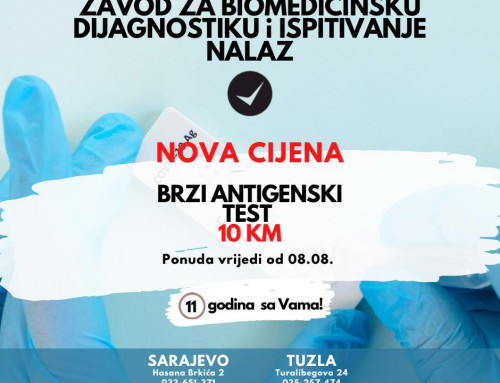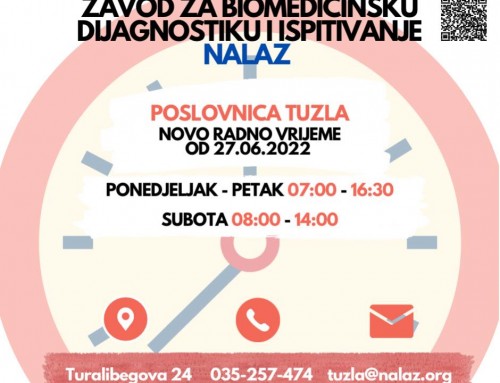NOVI KORACI U DIJAGNOSTICI HPV INFEKCIJE
LABORATORIJSKE METODE U PREDIKCIJI RAZVOJA KARCINOMA GRLIĆA MATERNICE – NASBA
Mr.sci. biomed. Irma Salimović- Bešić, MSc. biohemije
Zavod za biomedicinsku dijagnostiku i istrazivanje NALAZ posebnu pažnju posvećuje reproduktivnom zdravlju žena. Posebno mjesto u dijagnostici Zavoda NALAZ zauzima dijagnostika infekcije sa humanim papilomavirusom (HPV) i predviđanje toka i ishoda infekcije. Zavod za biomedicinsku dijagnostiku NALAZ je jedina ustanova u BiH, koja posjeduje NASBA tehnologiju i koji može na osnovu mjerenja nivoa mRNA za protein E6 i E7 virusa, pratiti aktivnost virusa i odrediti momenat kada perzistentna infekcija prelazi u invazivnu, koja dovodi do nastanka karcinoma.
HPV i karcinom grlića materice
Karcinom grlića materice je uzrokovan kod 99,7% slučajeva dugotrajnom (perzistentnom) infekcijom humanim papilomavirusom (HPV) (1). Većina takvih infekcija je prolaznog karaktera i ne dovodi do razvoja karcinoma grlića materice. Međutim, mali ali značajan broj HPV infekcija napreduje do takvog karcinoma (Slika 1). Prekomjernom sintezom virusnih onkoproteina E6 i E7 se narušavaju kontrolni mehanizmi ćelijskog ciklusa, što dovodi do maligne transformacije i prekanceroznih promjena ćelija (2) (Slika 2). Istraživanja sprovedena na uzorcima karcinoma grlića materice su pokazala da su genotipovi HPV-16 i HPV-18 zastupljeni u približno 70% slučajeva širom svijeta (3).
Slika 1. Prikaz karaktera HPV infekcije.
Slika 2. Nastanak karcinoma preko niza prekanceroznih promjena usljed HPV infekcije
Da li su dijagnostičke metode zasnovane na detekcije virusne (HPV) DNA adekvatan izbor za prognozu pojave karcinoma grlića materice?
Dijagnostičke metode zasnovane na detekciji virusnog genoma (HPV DNA) pokazuju samo da je virus prisutan u ćeliji, ali ne daju informaciju o onkogenoj aktivnosti virusa, niti da li infekcija ima prolazni ili dugotrajan karakter. Novije tehnologije preporučuju nove koncepte koji se više fokusiraju na detekciju specifičnijih faktora rizika- poput otkrivanja nivoa izražavanja virusnih onkogena E6 i E7, koji imaju ključnu ulogu u malignoj transformaciji inficirane ćelije. Nivo izražavanja gena se mjeri detekcijom mRNA.
Koji tip testa ima veću medicinsku prediktivnu vrijednost?
Detekcija mRNA onkoproteina HPV E6 i E7 je potvrda toga, da je u inficiranoj ćeliji prisutna dugotrajna sinteza virusnih onkoproteina, te da infekcija nema samo prolazni karakter. Stoga, ovakav način testiranja ima mnogo veći klinički značaj jer trijažira pacijentice koje su pod direktnim rizikom od razvoja karcinoma grlića materice. Medicinska prediktivna vrijednost detekcije HPV E6/E7 mRNA je veća u odnosu na testove zasnovane samo na otkrivanju prisustva HPV infekcije DNA testiranjem (4,5). Pokazalo se da se uz pomoć mRNA testiranja može isključiti veći broj žena sa normalnom citologijom i histologijom, tj., da test ima bolje parametre za isključivanje pacijentica koje nisu pod rizikom od razvoja karcinoma grlića materice (6).
Šta sa pacijenticama ispod 30 godina starosti?
Pošto je kod pacijentica mlađih od 30 godina veća zastupljenost prolaznih HPV infekcija, izbor HPV DNA testa kod ove populacije je od upitnog kliničkog značaja. Zbog toga su testovi detekcije mRNA i dugotrajne virusne onkogene aktivnosti od mnogo većeg prognostičkog i kliničkog značaja kod ove populacije žena u odnosu na metode detekcije virusne DNA (7).
Preporučeni algoritam za selekciju žena sa citološkim promjenama ASCUS/LSIL svih starosnih dobi dat je na slici 3.
Slika 3. Skrining program za otkrivanje promjena na grliću materice preporučen od strane Danske Administracije za zdravlje (8)
Druge moguće indikacije za E67E7 mRNA testiranje:
- Testiranje HPV DNA pozitivnih žena (iz primarnog skrininga)
- Praćenje pacijentica nakon liječenja
- Skrining HIV+ pacijentica
- Skrining i praćenje karcinoma koji nisu na grliću materice
- Praćenje poslije vakcinacije
Reference:
- Walboomers J et al, Human papillomavirus is a necessary cause of invasive cervical cancer worldwide. J. Pathol. 1999; 189:12-19.
- Zur Hausen et al, Papillomaviruses and cancer: from basic studies to clinical application. Nat. Rev. Cancer 2002; 2:342-50.
- Kahn et al, The elevated 10-year risk of high risk of cercical cancer in women with HPV type 16 or 18. J. Nat. Cancer Inst 2005; Vol. 97, n°14.
- Molden et al, Comparaison of HPV mRNA and DNA detection: a cross-sectional study of 4136 women >30 years of age with a 2-years follow-up of high grade sqamous intraepithelial lesion, Int. J. Cancer 2005; 114:973-976.
- Cuschieri et al, HPV type specific DNA and RNA persistence-implications for cervical Disease Progression and monitoring, J. Med. Virol.2004; 73:65-70.
- Lie et al, DNA- versus RNA-based methods for HPV detection in cervical neoplasia Gynec. Onc. 2005; 97: 908-915.
- Molden et al, HPV E6/E7 mRNA expression in women younger than 30 years of age, Gynec. Onc. 2006; 100:95-100.
- Screening for Cervical Cancer. Sundhedsstyrelsen, Denmark, 2007.
NEW STEPS IN DIAGNOSIS OF HPV INFECTION
THE LABORATORY METHODS TO PREDICT THE DEVELOPMENT OF CERVICAL CANCER – NASBA
Mr.sci.biomed. Irma Salimović- Bešić, MSc. of biochemistry
Institute for biomedical diagnostics and research- NALAZ pays close attention to the reproductive health of women. A special place in the diagnostics there occupies diagnosis of human papillomavirus (HPV) infection and predicting the course and outcome of infection. Institute for biomedical diagnostics and research- NALAZ is the only institution in B&H, which owns the NASBA technology and who can, based on measuring the levels of mRNA for viral oncoproteins E6 and E7, monitor virus activity and determine the moment when persistent infection becomes invasive, leading to the emergence of cancer.
HPV and cervical cancer
Cervical cancer is caused by the long-term (persistent) high-risk HPV infection in 99,7% of cases (1). Most HPV infections are transient and do not lead to cancer of the cervix. However, a small but significant number of HPV infections progress to such cancers (Figure 1). Excessive synthesis of viral oncoproteins E6 and E7 disrupt the mechanisms controlling the cell cycle, leading to malignant transformation of precancerous changes in infected cells (2) (Figure 2). Researches carried out on samples of cervical carcinoma showed that the genotypes of HPV-16 and HPV-18 are represented in approximately 70% of cases worldwide (3).
Figure 1. Course of HPV infection.
Figure 2. Cancer development through a series of precancerous changes caused by HPV infection (2)
Are the diagnostic methods based on the detection of virus (HPV) DNA adequate choice for prediction of occurrence of cervical carcinoma?
Diagnostic methods based on the detection of viral genome (HPV DNA) indicate only that the virus is present in the cell, but does not provide information on viral oncogenic activity, or that the infaction has transient or long-lasting character. Current technologies suggest new concepts that are focused on detection of more specific risk factors- such as the detection of overexpression of viral oncogenes E6 and E7, which play a critical role in malignant transformation of the infected cells. The level of gene expression is measured by detecting the gene transcripts (mRNA) in this case.
What type of test has greater medical predictive value?
mRNA detection of HPV oncoproteins E6 and E7 is a confirmation of the fact, that the infected cell established long-term synthesis of viral oncoproteins, and that infection is not only temporary. Therefore, such a test has a much greater clinical significance due to efficient triage of the patients who are under the direct risk of developing cervical cancer. Medical predictive value of detection of HPV E6/E7 mRNA was higher compared to tests based only on detecting the presence of HPV infection (detecting the viral genome) (4,5). It turned out that testing for the overexpression of HPV oncogenes can exclude a larger number of women with normal cervical cytology and histology, i.e., that test has a better performance for the exclusion of women who are not at risk of developing cervical cancer (6).
How to manage the women under 30 years of age?
Women under the age of 30 have higher prevalence of transient HPV infections and HPV DNA testing in this population is of questionable clinical significance. Therefore, detection of oncogenic HPV mRNA and consequently persistant viral oncogenic activity is of higher predictive and clinical value in relation to methods of detection of viral DNA for this population of women (7).
Recommanded algorithm for women of all ages with cytology results ASCUS/LSIL is given in figure 3.
Figure 3. Screening programme to detect changes in the cervix recommended by the Danish Administration of Health (8)
Other possible indications for implementing E67/E7 mRNA testing:
- Testing of HPV DNA positive women (from primary screening)
- Monitoring of patients after therapy
- Screening of HIV+ patients
- Screening and monitoring of non-cervical cancers
- Following after HPV vaccination
References:
- Walboomers J et al, Human papillomavirus is a necessary cause of invasive cervical cancer worldwide. J. Pathol. 1999; 189:12-19.
- Zur Hausen et al, Papillomaviruses and cancer: from basic studies to clinical application. Nat. Rev. Cancer 2002; 2:342-50.
- Kahn et al, The elevated 10-year risk of high risk of cercical cancer in women with HPV type 16 or 18. J. Nat. Cancer Inst 2005; Vol. 97, n°14.
- Molden et al, Comparaison of HPV mRNA and DNA detection: a cross-sectional study of 4136 women >30 years of age with a 2-years follow-up of high grade sqamous intraepithelial lesion, Int. J. Cancer 2005; 114:973-976.
- Cuschieri et al, HPV type specific DNA and RNA persistence-implications for cervical Disease Progression and monitoring, J. Med. Virol.2004; 73:65-70.
- Lie et al, DNA- versus RNA-based methods for HPV detection in cervical neoplasia Gynec. Onc. 2005; 97: 908-915.
- Molden et al, HPV E6/E7 mRNA expression in women younger than 30 years of age, Gynec. Onc. 2006; 100:95-100.
- Screening for Cervical Cancer. Sundhedsstyrelsen, Denmark, 2007.







